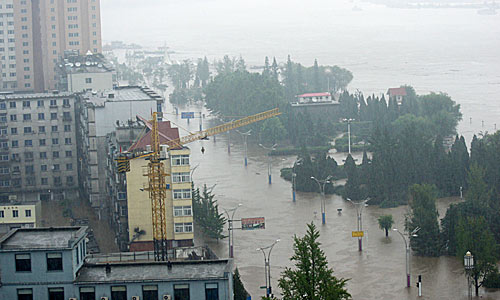|
 |
|
GETTING BACK ON HIS FEET: A drugstore owner in Zhouqu County, Gansu Province, cleans the sludge in front of his door on August 24, 17 days after disastrous landslides hit the county and killed more than 1,400 people (LIANG QIANG) |
Geological disasters have become natural disasters resulting in the second-largest number of casualties in China, following earthquakes, Xu said.
In southwest China's Yunnan Province, as of August 24, a total of 37 people were killed and 55 remained missing after mudslides hit the remote, mountainous town of Gongshan on August 18.
Between August 13 and 14, a total of 16 rain-triggered mudslides devastated Wenchuan County in southwest China's Sichuan Province, the epicenter of a massive earthquake in May 2008 that left some 87,000 people dead or missing. On August 14, in Yingxiu Township of Wenchuan, rows of newly completed homes were submerged by the overflowing Minjiang River which was clogged by mudslides.
Besides Wenchuan, persistent rainfall since August 12 has caused floods, landslides and mudslides in 67 counties in Sichuan, which have killed 16 people, affected 5.76 million and caused economic losses of 6.89 billion yuan ($1.01 billion) by August 19.
 |
|
CITY IN WATER: The photo taken on August 21 shows Dandong City, Liaoning Province, flooded by the swelling Yalu River (ZHAO GUILIANG) |
Geologists said the earthquake of 2008 took its toll on these areas in Sichuan, which were all located on the fault zone of the tremor. The strong quake shook the mountains in the areas, making them more prone to mudslides and other disasters, and the torrential rains finally triggered the slides, said He Ping, a member of the Chinese Research Institute of Geological Disasters. The same factor was also cited as a cause of landslides in Zhouqu, Gansu Province, which also suffered from casualties during the Wenchuan earthquake.
In Sichuan's neighboring Gansu, floods triggered by torrential rains on August 11 have left 42 people dead, 13 missing and 449 injured in two cities close to the mudslide-stricken Zhouqu by August 23. A total of 154,000 people in the cities of Longnan and Tianshui had been evacuated.
Xu attributed the disasters to frequent extreme weather such as severe droughts in China's southwestern areas in early 2010, rainstorms and to the impact of seismic activities.
He said China is still facing a tough situation in preventing geological disasters as August and September are the main flooding seasons in the country and there was still the possibility of torrential rain in some regions. |
